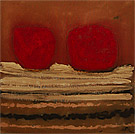Lindsay HARRIS

I am a Noongar artist and my interest has always been finding ways of representing my lands. I see through my eyes, which invoke memories of Kwolyin in the central Wheatbelt of Western Australia and the surrounding districts where I once lived. As a Noongar, I have, and I share in, a special relationship to the Country of my forebears. Overarching this relationship is the respect for my Country and my involvement in its care and representation.
When making my art, I introduce both memories and images of granite rocks, tracks and salt lakes. The bold brushstrokes in my paintings hide an underlying current of past tensions experienced by my people and their lands. I paint using resin, which gives me a feeling of marking and being connected to the land. I like to compare the markings I make to the tracks and paths that have crisscrossed my land since ancient times. I feel that my art has to give a sense of intimacy and connection to my boodja (land).
Through my painting, I invite people to go on a journey back to my land and see and understand it as I see it. My main endeavour is to help people make sense of the aesthetics of my land through utilising pigments, clay and natural resins of what is contained in my Jam Tree Country.[1]
Lindsay Harris the man is robust, yet his work is soft, even gentle, in effect. Imbued with a hypnotic quality or glow, the artist’s paintings radiate a subtle energy that almost overshadows the subject entirely.
The small country town of Kwolyin is the influence behind and the subject of Harris’s paintings. It is the place of his childhood and is located in the Wheatbelt region, the heartland of Western Australia’s agricultural industry, its landscape a veritable sea of paddocks. However, unlike the hive of activity in the greater Wheatbelt, Kwolyin now sits quiet.
Drawing on childhood memories of place, Harris traces the natural environment of Kwolyin in his work. Rocky granite outcrops, trees, lakes and Noongar cultural sites, in particular, are painted and rubbed into the canvas. Harris paints the natural features of Kwolyin using minimal forms. Lines, dashes, circles and passages of colour represent features in the landscape. Harris does not dabble in realist pictures, thus the subject of his work is never readily apparent. One could draw a parallel between the obscure in Harris’s paintings and the unseen Noongar connections to the Kwolyin landscape; it may not be overt, but it is there.
To quote the artist himself:
My paintings come from physical and spiritual nourishment created from having an intimacy when in my country. This is possibly why an explanation to the viewer is necessary about my art as it is difficult to fully appreciate the meaning if one has not been there and breathed and rested in these lands as I have.[2]
As Harris attests, his paintings come from knowledge that has been gained through lived experience, physical engagement and an inherited understanding of place. Each brushstroke and mark on the canvas reaffirms Harris’s relationship to his land, heritage and family. If only for a short while and if only in memory and on canvas, Harris bridges time, people and place. To recall Kwolyin is to remember the family with whom he shared it. The township is located inside Harris’s, and his mother’s, traditional lands.
Despite the easy availability of acrylic and other paints, Harris chooses to work exclusively with natural media; ochre, clay, resins and other pigments line the surface of organic hemp canvases. Harris’s choice of material is integral to the work. The resins and pigments are sourced from local sites in and near Kwolyin and greater South West region (Noongar Country) to anchor the connection between memory and place. Equally, this use of local materials undoubtedly serves to strengthen Harris’s recall of the sites, sounds and smells ever-present in his youth, further connecting him to family and home.
Harris’s preference for natural pigments is obvious yet also beguiling and puzzling: on the one hand, media sourced from the subject creates a direct connection to the subject; on the other, the pigments and resins Harris uses will inevitably break down, meaning the painting is inherently flawed—imperfect. Without conservation, Harris’s paintings will begin to unravel. Why has the artist chosen this material over a more permanent medium? Because he alerts us to impermanence:
Kwolyin town is now a ghost town with only a church remaining. However, when I am there, I can make out the barest foundations of its town-site. Impermanence is the word that best describes what I am seeing … Change is always occurring, nothing stays the same.[3]
Harris’s markings may very well echo the impermanence of moments in time, but they also alert us to the importance of memory and recollection, of recalling the past, and in remaining connected to Country, people and ourselves.
Carly Lane
[1] ‘Jam Tree Country’ is a reference to Kwolyin and its surrounds, where jam trees (Acacia acuminata) grow in abundance.
[2] Lindsay Harris, artist statement for his work in the exhibition Kaarlagup (place of my home, my fire), emerge ART SPACE, Perth, 2010.
[3] Harris, 2010, p 5.



